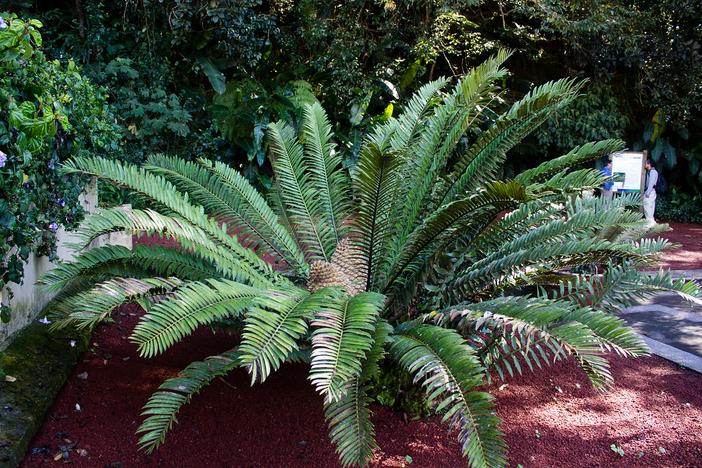Chestnut Dioon
(Dioon edule)
Chestnut Dioon (Dioon edule)
/
/

Tom Mushroom
CC BY-SA 2.0
Image By:
Tom Mushroom
Recorded By:
Copyright:
CC BY-SA 2.0
Copyright Notice:
Photo by: Tom Mushroom | License Type: CC BY-SA 2.0 | License URL: https://creativecommons.org/licenses/by-sa/2.0/ | Uploader: Tom Mushroom | Publisher: Flickr





























Estimated Native Range
Summary
Dioon edule, commonly known as Chestnut Dioon, is an evergreen cycad native to rocky hillsides and arid regions of the Gulf Coast of Mexico. This species is part of the ancient group of gymnosperms and is characterized by its pinnate leaves with unarmed (spineless) leaflets, which distinguishes it from other Dioon species. Dioon edule typically grows slowly to a height of 3-6 feet (1-2 meters) with a similar spread, forming a dense, symmetrical rosette of bluish-green leaves.
The Chestnut Dioon is valued for its architectural foliage and prehistoric appearance, making it a striking addition to xeriscapes, rock gardens, and as a container plant. It is drought-tolerant once established, requiring minimal maintenance and water. Dioon edule prefers well-draining soil and can tolerate a range of light conditions from full sun to part shade. While it is slow-growing, this cycad can live for many years and is relatively free of pests and diseases. It is dioecious, meaning individual plants are either male or female, with females having longer intervals between cone production. The cones themselves are not showy, but the rarity of their appearance can be of interest to plant enthusiasts.CC BY-SA 4.0
The Chestnut Dioon is valued for its architectural foliage and prehistoric appearance, making it a striking addition to xeriscapes, rock gardens, and as a container plant. It is drought-tolerant once established, requiring minimal maintenance and water. Dioon edule prefers well-draining soil and can tolerate a range of light conditions from full sun to part shade. While it is slow-growing, this cycad can live for many years and is relatively free of pests and diseases. It is dioecious, meaning individual plants are either male or female, with females having longer intervals between cone production. The cones themselves are not showy, but the rarity of their appearance can be of interest to plant enthusiasts.CC BY-SA 4.0
Plant Description
- Plant Type: Shrub
- Height: 6-8 feet
- Width: 4-6 feet
- Growth Rate: Slow
- Flower Color: N/A
- Flowering Season: Non-Flowering
- Leaf Retention: Evergreen
Growth Requirements
- Sun: Full Sun, Part Shade
- Water: Medium
- Drainage: Medium, Fast
Common Uses
Drought Tolerant, Edible*Disclaimer: Easyscape's listed plant edibility is for informational use. Always verify the safety and proper identification of any plant before consumption., Low Maintenance
Natural Habitat
Rocky hillsides and arid regions of the Gulf Coast of Mexico
Other Names
Common Names: Cycad, Edible-Seed Cycas, Palma De La Virgen, Mexikansk Kottepalm
Scientific Names: , Dioon edule, Dion edule, Dioon edule var. edule, Dioon edule f. edule, Macrozamia pectinata, Macrozamia littoralis, Dioon edule subsp. edule, Dioon edule var. imbricatum, Dioon edule var. lanuginosum
GBIF Accepted Name: Dioon edule Lindl.